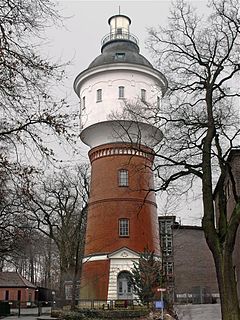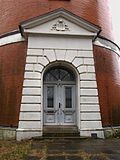Hamburg-Bergedorf water tower
The former water tower of Bergedorf stands on the edge of the villa district on the Pfingstberg, a hill above the Bille . The buildings of the Luisen-Gymnasium cover a large part of the 31 m high tower, so that only its top can be seen from the residential area.
Building
The tower was built in 1903 based on a design by the Bergedorf city architect Carl Friedrich Dusi. The architectural style is characteristic of historicism .
The shaft is made of brickwork and tapers towards the top. A neoclassical entrance portal with rustic decor dominates the ground floor. It is gabled and bears the Bergedorf coat of arms in the gable field. The two floors above are optically separated from each other by a brick frieze. Below the container area there is another frieze made of brick consoles with plastered panels.
The tower head protrudes quite clearly and, unlike the shaft, consists of concrete painted white. A wreath of narrow windows provides exposure. Stucco-like elements form arches over the windows, which are complemented by decorative shapes.
The incompletely dome-shaped roof is slated . It ends with a viewing gallery that is bordered by a wrought iron railing. A lantern gives access to the gallery.
Inside the tower, a staircase leads along the outer wall of the shaft up to the drip tray. Above, inside the head, is the Intze-1 container , which originally held 230 m³ of water . An inner cylinder in the center of the container contains a spiral staircase that can be used to get through the container to the viewing gallery.
→ For more information on the container shapes, see the main article on the water tower
History of the water supply in Bergedorf
Since Bergedorf was administered by Hamburg from 1876, many Hamburgers settled as new residents in Bergedorf. The central water supply in town began in 1885 with the commissioning of a waterworks on the Bille. First, the river water was used and roughly filtered. It was pumped into a 600 m³ elevated tank on the Pfingstberg by means of a steam engine pump in order to ensure even pressure.
However, the quality of the river water left a lot to be desired, so that in 1899 two deep wells were drilled. Their iron-rich water ran through a de-ironing system and then showed perfect quality. Unfortunately, the water pressure caused by the elevated tank was not sufficient for higher-lying houses. The city also feared extinguishing water problems in the event of a fire. The magistrate therefore decided to build a water tower next to the elevated tank . The tower, which went into operation in 1903, should also serve as a lookout tower. The offer was hardly accepted by the population, so that before the First World War the viewing gallery was no longer open to the public.
From 1929 to 1931 the Luisen-Gymnasium was built directly in front of the water tower. The school building designed by Fritz Schumacher almost completely covered the tower. This illustrates the disdain for the Wilhelmine architectural style during the New Building era .
In 1973 the Bergedorf water tower was shut down at the same time as the water tower in neighboring Lohbrügge . Modern pumping systems had made water towers to maintain constant water pressure superfluous. The elevated tank next to the Bergedorfer Tower had to give way to a school extension in the 1990s.
The groundwater works on the Bille, built in 1899 and modernized several times, is still in operation. It has belonged to the Hamburg waterworks since 1938 . It supplies the Reinbek , Wentorf and part of Bergedorf area with drinking water.
Monument protection and conversion
Plans to convert the building for social purposes failed because of the remote location and the high costs for renovation and maintenance. The tower was therefore offered for sale and acquired by a private person in 1983. In 1986 the cultural authority placed the building under monument protection . The new owner converted the tower into an apartment taking into account the monument protection requirements. Contrary to expectations, the tower head had to be completely renewed. The water tank is still there. Doors were cut into the inner cylinder so that two semicircular rooms could be set up in the container.
gallery
See also
literature
- Jens U. Schmidt: Water towers in Bremen and Hamburg. Hanseatic water towers . Regia-Verlag, Cottbus 2011, ISBN 978-3-86929-190-1 .
swell
- Information boards of the Free and Hanseatic City of Hamburg on the Bergedorf Water Tower and the Luisen Gymnasium are attached to the structures
Web links
- Hamburger Wasserwerke - History of the water supply in Hamburg
- Hamburger Wasserwerke - Information about the Bergedorf waterworks
Coordinates: 53 ° 29 ′ 31.9 ″ N , 10 ° 13 ′ 42.7 ″ E






